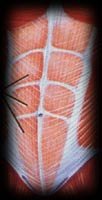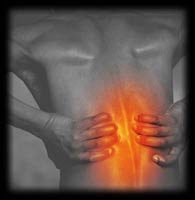 The importance of strengthening the abdominal (or "abs") cannot be overemphasized. The functions of the mid-section include flexion, lateral flexion and rotation of the torso as well as flexion of the hip. Collectively, the muscles of this region keep the abdominal organs compressed and assist in forced expiration (as during vigorous exercise).
The importance of strengthening the abdominal (or "abs") cannot be overemphasized. The functions of the mid-section include flexion, lateral flexion and rotation of the torso as well as flexion of the hip. Collectively, the muscles of this region keep the abdominal organs compressed and assist in forced expiration (as during vigorous exercise).
Therefore, virtually all sports require the use of the abdominals to some degree. In addition, having a strong mid-section will remove stress that tends to build up in our lower backs from being sedentary.
Basic Anatomy and Muscular Function
The abdominal muscles can be divided into two groups: the upper and the lower. The upper abdominal wall consists of four pairs of thin muscles arranged in layers connecting the rib cage with the pelvic girdle.
The muscle fibers run in three different directions: diagonally, vertically and horizontally. This mycological arrangement helps to strengthen the abdominal wall and to stabilize the trunk.
 The external obliques are the outermost covering of the three layers on both sides of the abdomen. The fibers of this broad muscle form a "\/" across the front of the abdominal area, extending diagonally downward from the lower ribs to the pubic bone. The internal obliques lie immediately under the external obliques on both sides of the abdomen.
The external obliques are the outermost covering of the three layers on both sides of the abdomen. The fibers of this broad muscle form a "\/" across the front of the abdominal area, extending diagonally downward from the lower ribs to the pubic bone. The internal obliques lie immediately under the external obliques on both sides of the abdomen.
These fibers form a "/\" (an inverted "\/") along the front of the abdominal wall, extending diagonally upward from the pubic bone to the ribs. The rectus abdominis lies on the same layer as the internal oblique. It is a long, narrow muscle that runs vertically across the front of the abdomen from the rib cage to the pubic bone. The transverse abdominis is the innermost layer of the abdominal wall. It is the thinnest of all abdominal muscles and its fibers run horizontally across the abdomen.
General Guidelines
The following general guidelines apply when training the abdominals:
- Exercise the abs at the end of your workout. Remember, the abdominals stabilize the rib cage and aid in forced expiration. So, it would not be wise to fatigue your mid-section early in your workout since this would detract from your performance in the other exercises that involve the larger, more powerful muscles (i.e. the hips, legs and upper torso).
Exercise the upper abs before the lower abs. For example, when performing a ab crunch, a person uses his rectus abdominis and iliopsoas (or hip flexor). The iliopsoas is the "weak link" in executing a sit-up. This means that your hip flexors -- i.e. your lower abs -- will fatigue well before your upper abs.
- The Preferred exercise for the abdominals is the "crunch". A "crunch" is actually a modified sit-up with a restricted range of motion. The beginning position for a crunch is to lie on the floor and place the backs of your lower legs on a bench or a stool. The angle between your upper and lower legs should be about 90 degrees. Placing your legs on a bench or a stool in this manner will cause your iliopsoas muscle to relax, thereby reducing the load on your lumbar spine.
- Fold your arms across your chest or place your hands behind your neck and lift your head off the floor so that your chin is tucked into your chest. (You can also keep your arms flat on the floor at your sides.) To do this movement, bring your torso up as high as possible. Pause briefly in this position and then lower yourself under control to the starting position (don't let your head touch the floor). Once again, avoid throwing your arms and/or head forward as you do the exercise.
- A hanging leg raise is a productive exercise for training the iliopsoas and the lower portion of the abdominals. To assume the starting position, reach up, hang from a chin-up bar and cross your ankles. To begin the movement, simply bring your knees up to your chest, pause briefly in this position and then lower your legs under control back to the starting position.
- Once you can perform a set of 12 reps in strict form, you can increase the workload on your muscles by performing the exercise slower or by having someone apply manual resistance to your upper legs.
Perform all exercises in good form. Good form is raising your body without the use of momentum in about 1 - 2 seconds, pausing distinctly in the contracted (or mid-range) position and lowering your body under control in about 3 - 4 seconds.
This will ensure that your abdominal muscles are raising your body (rather than momentum) and that your chances of incurring an injury while strength training are minimized. 
Avoid hyper-extending the spine. People frequently complain of low back pain while executing abdominal exercises. This is usually the result of having relatively weak lumbar extensors, performing the exercise incorrectly or a combination of the two. For instance, sit-ups (or any variation of a sit-up) should be performed with your knees bent and your chin tucked into your chest.
This will help keep your lower back flat, thereby reducing the amount of stress placed on it during the performance of the exercise. Under no circumstances should the so-called "Roman Chair" sit-up be done because this particular movement hyper-extends the spine and places undue stress on the low back area. In the case of weak low back muscles, strengthening exercises (such as back extensions) should be prescribed.
Keep tension on the abdominals throughout the entire duration of the exercise. As an example, your abdominals are used during the first 30 degrees of a conventional bent-knee sit-up movement (with respect to the horizontal). So, its not necessary to bring your torso all the way up to your legs.
In fact, when performing a bent-knee sit-up you should stop before your upper torso goes beyond a point that is perpendicular to the ground. In addition, don't let your head touch the sit-up board between reps. Otherwise, you'll take the tension off your abdominals allowing them to rest and momentarily recover.
Reach momentary muscular failure between 10 -15 reps (or 40 - 70 seconds). Momentary muscular failure may best be defined as that instant when it is literally impossible for you to perform another repetition in good form.
It is not necessary to perform thousands -- or even hundreds -- of repetitions in order to strengthen the abdominals. The abdominals should be treated like any other muscle group. Once an activity for the abdominals exceeds about 70 seconds in duration, it becomes a test of endurance rather than strength.
Key points for ab training (summary)
1. Train your abs like any other muscle group and don't train them on consecutive days. 3 days a week is plenty if your doing the movements correct.
2. On the top portion of any ab movement, you want to pause for a beat.
3. Control the movement and do the exercise slow.
4. Breath out and tighten the abs during the exertion of the exercise.
5. Press your lower back (flatten it) down towards the floor while crunching.
6. Place your hand behind you neck and not on your head.
7. Only crunch up for 4 to 6 inches.
8. Mix up the order for the following ab routines, but warm up the abs with the regular crunch.
|
U = upper abs,
L = lower abs,
O = obliques
|
||||
| ONE | ||||
| 1. | Regular crunch | U | 2 set for 15 reps | |
| 2. | Reverse crunch | L | 2 sets for 15 reps | |
| 3. | Hanging leg raise | L | 2 sets for 15 reps | |
| 4. | Side crunch | O | 2 sets each side for 10 reps | |
| 5. | Regular crunch | U | 1 set for 20 reps | |
| TWO | ||||
| 1. | Regular crunch | U | 2 set for 15 reps | |
| 2. | Twist crunch | O | 2 sets each side for 10 reps | |
| 3. | Reverse crunch | L | 2 sets for 15 reps | |
| 4. | Roman crunch | 4. | 2 set for 15 reps | |
| 5. | Rope Pulldown crunch | U | 1 set for 20 reps | |
For questions or comments please visit www.FitFranco.com
Any questions, comments or information on personal training, you can contact Joe Franco at:
